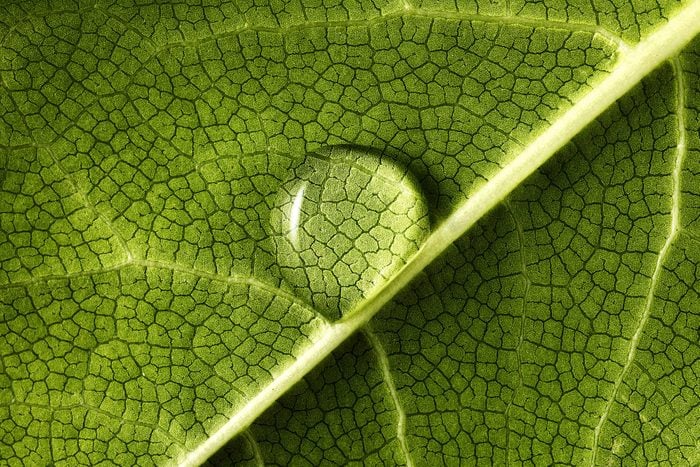If Your Indoor Plant Has Water Droplets On Its Leaves, This Is What It Means
Updated: Dec. 22, 2022

Deciphering those drippy leaves is easier than you might think and reveals the secret to healthy, happy plants.
All plant parents, whether seasoned or amateur, recognize that plants speak their own language. Their color, positioning and leaf texture all carry specific messages. And learning to respond to these messages can help you save a houseplant on the brink.
Recently, aspiring green thumbs have been asking about one particular symptom: water droplets on the leaves of their indoor plants. Don’t worry—your plant isn’t crying! With a little help decoding this behavior and one simple adjustment, your leafy buddy will be back to normal in no time.
Why Does a Plant Create Water Droplets?
There are three main reasons you may spot water droplets on your plants. Learn about each of them to identify which may be causing your plant’s droplets.
Transpiration
This fancy term is used to describe a plant’s natural water exchange process. A plant sucks up water from its roots, and when it has received as much as it needs, it releases the excess water through its leaves. Think of it as a plant’s version of sweating.
Dew
Dew may cause water droplets on houseplant leaves in much the same way as it causes droplets on your lawn. When there is a temperature difference between the plant and its surrounding air, atmospheric moisture will condense on the warmer surface, the plant’s leaves.
Guttation
Guttation is a process by which plants release water, nutrients and minerals in the form of xylem sap. This sap is often mistaken for plain water and is most common in certain varieties of plants, such as succulents and fruit and vegetable plants.
Are Water Droplets a Problem?
Not necessarily. Dew droplets are fine, as are small quantities of transpiration droplets and natural guttation in affected plants. However, if you see more than a drop or two falling off the end of your plant’s leaves, this is likely a sign of overwatering and needs to be addressed.
What Are Other Symptoms of Overwatering?
To confirm that overwatering is the underlying issue, check for these other side effects:
- Wet and/or moldy soil
- Wilting and/or dropping leaves
- Mushy or unstable stems
- Yellow leaves and/or brown spots
If any of these symptoms resonate with you, it’s time to reevaluate your watering schedule.
How Do I Fix a Waterlogged Plant?
In most cases, the solution is to stop watering until the soil is completely dry throughout, usually a few weeks. To ensure the soil is appropriately dry, dig a finger in deep, or use a wooden chopstick or moisture meter. Be sure to check multiple places in the pot for a holistic picture.
However, if your plant exhibits all signs outlined above, it’s best to repot it, trimming off any rotten roots, which will appear black and mushy.
How Do I Properly Water My Plant Going Forward?
The key to giving your plant the right amount of water is to consistently check the soil. If it is completely dry throughout, as explained above, water the plant until it drains freely from the bottom of the pot. The pot should feel heavy and the soil should look moist, but there shouldn’t be any standing water at the surface. If the soil is not yet dry throughout, wait a few days and then check again.
Am I Doing This Right?
Good plant parenting is all about getting to know your individual plants and listening to their natural rhythms. Always trust the plant itself over your calendar notifications for watering, and you’ll do just fine. And if after all this you’ve decided you’re not a green thumb after all, don’t underestimate the aesthetic appeal of a good artificial plant.